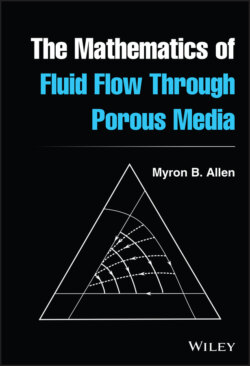Читать книгу The Mathematics of Fluid Flow Through Porous Media - Myron B. Allen III - Страница 21
2.2.2 Momentum Balance
ОглавлениеThe differential momentum balance equation is
(2.9)
often called Cauchy's first law. (For its derivation from an integral form, see [4, Chapter 4]. Strictly speaking, the momentum balance states that there exists a frame of reference in which Cauchy's first law holds.) Each term in Eq. (2.9) is a vector‐valued function having dimension . Thus, Cauchy's first law comprises three scalar PDEs.
The terms in Eq. (2.9) require explanation. First, with respect to any orthonormal basis ,
so applying this operator to yields
which is clearly a vector‐valued function.
Second, the function represents the body force per unit mass, having dimension . In this book, the only body force of interest is gravity, and reduces to the gravitational acceleration near Earth's surface. The total body force acting on a part of the body is
where is the region occupied by the part.
Third, the function is the stress tensor. This entity deserves more extended discussion, starting with the term tensor. A second‐order tensor is a linear transformation that maps vectors into vectors. Its geometric action remains fixed under changes in coordinate systems, a requirement discussed in more detail in Section 3.7. The stress tensor is a linear transformation that describes a type of force different from the body force.
More specifically, any part of a body occupying a region in three‐dimensional space can experience forces acting on the region's bounding surface . We account for these forces by introducing tractions, having dimension force per unit area:
Consider such a region, as drawn in Figure 2.6. At any point where the bounding surface is smooth and orientable, there exists an outward pointing unit normal vector that is orthogonal to the plane tangent to at that point. The stress tensor is a linear transformation such that the vector field gives the traction at any point on . The vector field need not be collinear with : The force per unit area acting at a point on can have a component tangent to the surface. The total force acting on is
having dimension .
Four additional remarks help clarify the nature of the stress tensor.
1 With respect to any orthonormal basis , any linear transformation has a matrix representation with entries . For , this representation has the formFigure 2.6 A region in three‐dimensional space with unit outward normal vector field and the traction acting on the boundary .
2 In accordance with Exercise 2.4, with respect to any orthonormal basis, the diagonal entries represent forces per unit area acting in directions perpendicular to faces that are orthogonal to , , and , respectively. We refer to these entries as tensile stresses when they pull in the same direction as and as compressive stresses when they push in the opposite direction—namely inward—from . The off‐diagonal entries , where , are shear stresses.
3 A classic theorem in continuum mechanics reduces the angular momentum balance, which we do not discuss here, to the identity with respect to any orthonormal basis. In other words, the stress tensor is symmetric. See [4, Chapter 4] for details.
4 With respect to an orthonormal basis , the divergence of the tensor‐valued function has the following representation as a vector‐valued function:
Exercise 2.4 Consider the action of on each unit basis vector , , to examine the forces acting on faces of a cube of material whose edges lie parallel to the Cartesian coordinate axes defined by , as drawn in Figure 2.7. Justify the assertion that represents the th component of the force per unit area acting on surfaces that lie perpendicular to .
Figure 2.7 A cube of material illustrating the interpretations of entries of the stress tensor matrix with respect to an orthonormal basis, from [4, page 109].
The differential momentum balance (2.9) generalizes Newton's second law of motion. The left side of Eq. (2.9) is proportional to mass acceleration, while the right side is proportional to a sum of forces. Thus, Eq. (2.9) has the form
Based on this parallel, fluid mechanicians call
the inertial terms.
If we view the momentum balance as an equation for the velocity , the inertial terms make the momentum balance a nonlinear PDE. In many applications to fluid mechanics, this nonlinearity wreaks mathematical havoc. Mercifully, for reasons examined in Chapter 3, the inertial nonlinearity plays a negligible role in the most commonly used models of porous‐media flow. However, this observation furnishes scant grounds for complacency. As subsequent chapters demonstrate, other types of nonlinearity play prominent roles in the fluid mechanics of porous media.
